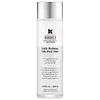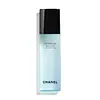What's inside
What's inside
 Key Ingredients
Key Ingredients

 Benefits
Benefits

 Concerns
Concerns

 Ingredients Side-by-side
Ingredients Side-by-side

Water
Skin ConditioningHydrogenated Polydecene
EmollientCaprylic/Capric Triglyceride
MaskingSqualane
EmollientCarthamus Tinctorius Seed Oil
Masking1,2-Hexanediol
Skin ConditioningPEG-6 Caprylic/Capric Glycerides
EmulsifyingPEG-40 Glyceryl Cocoate
EmulsifyingPhenoxyethanol
PreservativeSodium Coceth Sulfate
CleansingCapryloyl Salicylic Acid
ExfoliatingTromethamine
BufferingEthylhexylglycerin
Skin ConditioningCitrus Nobilis Peel Oil
MaskingAdenosine
Skin ConditioningLimonene
PerfumingCaprylyl Glycol
EmollientAnthemis Nobilis Flower Oil
MaskingCupressus Sempervirens Leaf/Nut/Stem Oil
EmollientPrunus Amygdalus Dulcis Seed Extract
Skin ConditioningBenzyl Alcohol
PerfumingXanthan Gum
EmulsifyingSilybum Marianum Extract
Skin ConditioningTocopherol
AntioxidantDehydroacetic Acid
PreservativeLactic Acid
BufferingWater, Hydrogenated Polydecene, Caprylic/Capric Triglyceride, Squalane, Carthamus Tinctorius Seed Oil, 1,2-Hexanediol, PEG-6 Caprylic/Capric Glycerides, PEG-40 Glyceryl Cocoate, Phenoxyethanol, Sodium Coceth Sulfate, Capryloyl Salicylic Acid, Tromethamine, Ethylhexylglycerin, Citrus Nobilis Peel Oil, Adenosine, Limonene, Caprylyl Glycol, Anthemis Nobilis Flower Oil, Cupressus Sempervirens Leaf/Nut/Stem Oil, Prunus Amygdalus Dulcis Seed Extract, Benzyl Alcohol, Xanthan Gum, Silybum Marianum Extract, Tocopherol, Dehydroacetic Acid, Lactic Acid
Water
Skin ConditioningPEG-32
HumectantPEG/PPG/Polybutylene Glycol-8/5/3 Glycerin
HumectantPEG-11 Methyl Ether Dimethicone
EmulsifyingMethyl Gluceth-20
HumectantGlycerin
Humectant1,2-Hexanediol
Skin ConditioningAlgae Extract
EmollientSalicornia Herbacea Extract
Skin ConditioningSodium Citrate
BufferingSodium PCA
HumectantPPG-13-Decyltetradeceth-24
EmulsifyingCitric Acid
BufferingPotassium Sorbate
PreservativeParfum
MaskingMaris Aqua
HumectantSodium Hyaluronate
HumectantPhytic Acid
Caprylic/Capric Triglyceride
MaskingSodium Hydroxide
BufferingSodium Benzoate
MaskingTocopherol
AntioxidantWater, PEG-32, PEG/PPG/Polybutylene Glycol-8/5/3 Glycerin, PEG-11 Methyl Ether Dimethicone, Methyl Gluceth-20, Glycerin, 1,2-Hexanediol, Algae Extract, Salicornia Herbacea Extract, Sodium Citrate, Sodium PCA, PPG-13-Decyltetradeceth-24, Citric Acid, Potassium Sorbate, Parfum, Maris Aqua, Sodium Hyaluronate, Phytic Acid, Caprylic/Capric Triglyceride, Sodium Hydroxide, Sodium Benzoate, Tocopherol
 Reviews
Reviews

Alternatives
Ingredients Explained
These ingredients are found in both products.
Ingredients higher up in an ingredient list are typically present in a larger amount.
1,2-Hexanediol is a synthetic liquid and another multi-functional powerhouse.
It is a:
- Humectant, drawing moisture into the skin
- Emollient, helping to soften skin
- Solvent, dispersing and stabilizing formulas
- Preservative booster, enhancing the antimicrobial activity of other preservatives
This ingredient is an emollient, solvent, and texture enhancer. It is considered a skin-softener by helping the skin prevent moisture loss.
It helps thicken a product's formula and makes it easier to spread by dissolving clumping compounds.
Caprylic Triglyceride is made by combining glycerin with coconut oil, forming a clear liquid.
While there is an assumption Caprylic Triglyceride can clog pores due to it being derived from coconut oil, there is no research supporting this.
Learn more about Caprylic/Capric TriglycerideTocopherol (also known as Vitamin E) is a common antioxidant used to help protect the skin from free-radicals and strengthen the skin barrier. It's also fat soluble - this means our skin is great at absorbing it.
Vitamin E also helps keep your natural skin lipids healthy. Your lipid skin barrier naturally consists of lipids, ceramides, and fatty acids. Vitamin E offers extra protection for your skin’s lipid barrier, keeping your skin healthy and nourished.
Another benefit is a bit of UV protection. Vitamin E helps reduce the damage caused by UVB rays. (It should not replace your sunscreen). Combining it with Vitamin C can decrease sunburned cells and hyperpigmentation after UV exposure.
You might have noticed Vitamin E + C often paired together. This is because it is great at stabilizing Vitamin C. Using the two together helps increase the effectiveness of both ingredients.
There are often claims that Vitamin E can reduce/prevent scarring, but these claims haven't been confirmed by scientific research.
Learn more about TocopherolWater. It's the most common cosmetic ingredient of all. You'll usually see it at the top of ingredient lists, meaning that it makes up the largest part of the product.
So why is it so popular? Water most often acts as a solvent - this means that it helps dissolve other ingredients into the formulation.
You'll also recognize water as that liquid we all need to stay alive. If you see this, drink a glass of water. Stay hydrated!
Learn more about Water